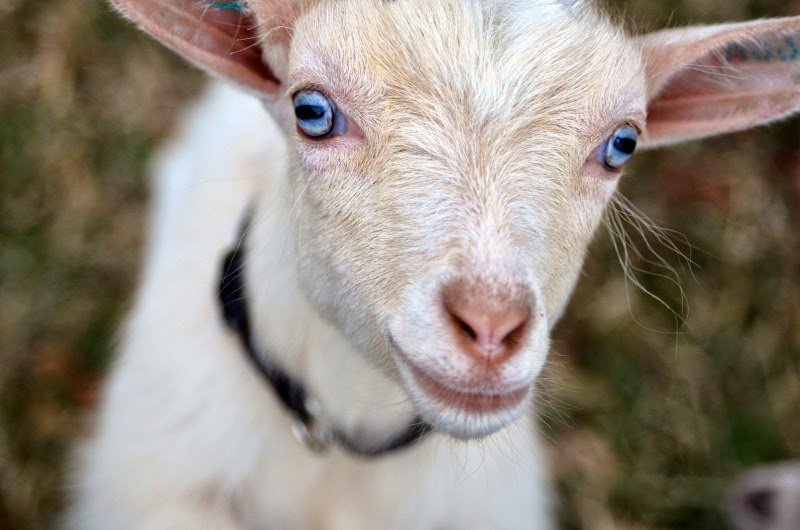History of Goats
Origins of the Goat
Goats were one of the first animals to be tamed by humans and were being herded 9,000 years ago. They are a member of the cattle family and are believed to be descended from the wild goat, bezoar.
Goat Names and Terminology
You will often hear goats referred to by the following: "Buck or Billy" - a male goat. "Doe or Nanny" - a female goat. "Kid" - a young goat. "Wether" - a castrated male goat. "Hermaphrodite" - a goat showing both female and male characteristics, most likely unable to reproduce. "Herd" - a group of goats. "Wattles" - little round balls of fur on a goats' neck close to its chin. Not all goats have wattles.
Teeth
Goats have a lower set of teeth which meet a hard pad in the upper jaw, and 24 molars on the top and bottom in the back of their mouths. Kids have 8 small, sharp teeth in their lower front jaw, and like children, when their baby teeth fall out they are replaced by permanent teeth. The age of a goat can often be closely determined by their teeth.
Health
The overall health of a goat is largely determined by their environment, genetics and nutrition. There are a number of illnesses that can affect a goat both in chronic and curable form. Some of these illnesses can be passed to humans and other animals while some illnesses are specific to goats. Much research is being done to provide more drugs that are approved for use in goats. Two illnesses that can bring sudden death to a goat are coccidiosis and pneumonia. Of most concern to breeders and producers are worms and parasites. A goat that is ridden with parasites and worms and left untreated will most likely suffer a rapid decline in health, production and often result in death.
Weight and Physical Characteristics
Depending on their breed, female goats weigh between 22 to 220 pounds, whereas male goats weigh between 27 to 275 pounds and are bigger and shaggier in appearance than females. Male goats are also endowed with beards that grow longer as they get older. Female goats are also capable of growing a beard. With the advent of the Boer or "meat goat" in the United States, these standards are becoming somewhat variable. Cross-breeding and genetics have begun paving the future for new breeds of goats which will undoubtedly exceed current standards. Many a breeder and producer will share that their particular line of goats will often be bred for a specific characteristic or feature. It is important to understand that a "desirable" characteristic to one producer may be "undesirable" to another.
Coloration
Widely accepted as a "standard", depending upon the breed, goats may be cream, white, black or brown in coloring. However, as more cross-breeding and genetic enhancement is achieved, the results are often dazzling sets of colors not previously seen. In my experiences, cross-breeding can often result in the offspring displaying both sets of colors from the original breeds. These cross-bred goats are often referred to as "Brush Goats".
Eyes
The pupil in a goat's eye is rectangular in shape instead of being round like those of other animals. It is believed that goats have excellent night vision and will often browse at night. The actual color of the goat's eyes is varied with the most common color being yellow or brown. Blue coloration is a bit rarer and often a characteristic many breeders will try to achieve.
Lifespan
Goaespants generally live 10 to 12 years. There have been cases of goats living up to 15 years.
Behavior
The behavior of a goat can vary widely based upon a number of factors such as breed, surroundings, and size of the herd. For the most part, goat behavior is often summed up as: goats are very sociable, lively, inquisitive and independent animals. They are also quite intelligent and can learn how to open latches on farm gates. Goats are also herd animals. One particular behavior of goats that is intriguing is that while they are independent, they often prefer to surround themselves with goats of their same breed in a mixed herd. Another example of goat behavior is that the kids will prefer to remain nearby their mother, even if separated for years and reintroduced.
Physical Capabilities
Goats can climb, run, crawl under fences and some breeds of goats are able to jump heights of over 5 feet. It should be noted as well that most goats will also stand on their back legs to reach tree branches and shrubs.
Produce
The main products associated with goats are milk, cheese, meat, mohair, and cashmere. Large dairy does produce 3,000 to 5,000 pounds of milk each year. (On a daily basis they produce 2 or 3 quarts of milk). With the emphasis on genetics, it should be noted that breeders and producers are beginning to surpass previous levels of milk and meat production with daily yields often exceeding one gallon of milk per day.
.jpg)



No comments:
Post a Comment